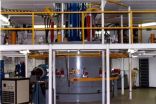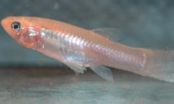(Press-News.org) Like gravity, the strong interaction is a fundamental force of nature. It is the essential "glue" that holds atomic nuclei—composed of protons and neutrons— together to form atoms, the building blocks of nearly all the visible matter in the universe. Despite its prevalence in nature, researchers are still searching for the precise laws that govern the strong force. However, the recent discovery of an extremely exotic, short-lived nucleus called fluorine-14 in laboratory experiments may indicate that scientists are gaining a better grasp of these rules.
Fluorine-14 comprises nine protons and five neutrons. It exists for a tiny fraction of a second before a proton "drips" off, leaving an oxygen-13 nucleus behind. A team of researchers led by James Vary, a professor of physics at Iowa State University, first predicted the properties of fluorine-14 with the help of scientists in Lawrence Berkeley National Laboratory's (Berkeley Lab's) Computational Research Division, as well as supercomputers at the National Energy Research Scientific Computing Center (NERSC) and the Oak Ridge Leadership Computing Facility. These fundamental predictions served as motivations for experiments conducted by Vladilen Goldberg's team at Texas A&M's Cyclotron Institute, which achieved the first sightings of fluorine-14.
"This is a true testament to the predictive power of the underlying theory," says Vary. "When we published our theory a year ago, fluorine-14 had never been observed experimentally. In fact, our theory helped the team secure time on their newly commissioned cyclotron to conduct their experiment. Once their work was done, they saw virtually perfect agreement with our theory."
He notes that the ability to reliably predict the properties of exotic nuclei with supercomputers helps pave the way for researchers to cost-effectively improve designs of nuclear reactors, to predict results from next generation accelerator experiments that will produce rare and exotic isotopes, as well as to better understand phenomena such as supernovae and neutron stars.
"We will never be able to travel to a neutron star and study it up close, so the only way to gain insights into its behavior is to understand how exotic nuclei like fluorine-14 behave and scale up," says Vary.
Developing a Computer Code to Simulate the Strong Force
Including fluorine-14, researchers have so far discovered about 3,000 nuclei in laboratory experiments and suspect that 6,000 more could still be created and studied. Understanding the properties of these nuclei will give researchers insights into the strong force, which could in turn be applied to develop and improve future energy sources.
With these goals in mind, the Department of Energy's Scientific Discovery through Advanced Computing (SciDAC) program brought together teams of theoretical physicists, applied mathematicians, computer scientists and students from universities and national laboratories to create a computational project called the Universal Nuclear Energy Density Functional (UNEDF), which uses supercomputers to predict and understand behavior of a wide range of nuclei, including their reactions, and to quantify uncertainties. In fact, fluorine-14 was simulated with a code called Many Fermion Dynamics–nuclear (MFDn) that is part of the UNEDF project.
According to Vary, much of this code was developed on NERSC systems over the past two decades. "We started by calculating how two or three neutrons and protons interact, then built up our interactions from there to predict the properties of exotic nuclei like fluorine-14 with nine protons and five neutrons," says Vary. "We actually had these capabilities for some time, but were waiting for computing power to catch up. It wasn't until the past three or four years that computing power became available to make the runs."
Through the SciDAC program, Vary's team partnered with Ng and other scientists in Berkeley Lab's CRD who brought discrete and numerical mathematics expertise to improve a number of aspects in the code. "The prediction of fluorine-14 would not have been possible without SciDAC. Before our collaboration, the code had some bottlenecks, so performance was an issue," says Esmond Ng, who heads Berkeley Lab's Scientific Computing Group. Vary and Ng lead teams that are part of the UNEDF collaboration.
"We would not have been able to solve this problem without help from Esmond and the Berkeley Lab collaborators, or the initial investment from NERSC, which gave us the computational resources to develop and improve our code," says Vary. "It just would have taken too long. These contributions improved performance by a factor of three and helped us get more precise numbers."
He notes that a single simulation of fluorine-14 would have taken 18 hours on 30,000 processor cores, without the improvements implemented with the Berkeley Lab team's help. However, thanks to the SciDAC collaboration, each final run required only 6 hours on 30,000 processors. The final runs were performed on the Jaguar system at the Oak Ridge Leadership Computing Facility with an Innovative and Novel Computational Impact on Theory and Experiment (INCITE) allocation from the Department of Energy's Office of Advanced Scientific Computing Research (ASCR).
INFORMATION:
The paper that predicts fluorine-14 was published in Physical Letters C Rapid Communications. In addition to Vary, Pieter Maris, also of Iowa State, and Andrey Shirokov of Moscow State University were co-authors on the paper. In addition to Ng, Chao Yang and Philip Sternberg (a former postdoc), also of Berkeley Lab, and Masha Sosonkina of Ames Laboratory at Iowa State University contributed to the project.
For additional information on UNEDF visit: http://www.scidac.gov/physics/unedf.html.
The paper that describes the first observations of fluorine-14 was published in Physics Letters B.
For more news from Berkeley Lab Computing Sciences, please visit: www.lbl.gov/cs.
Proton dripping tests a fundamental force in nature
2011-05-11
ELSE PRESS RELEASES FROM THIS DATE:
Photographer Reflects on 9/11 Hero in the Aftermath of Osama Bin Laden's Death
2011-05-11
National photographer Paul Mobley reflects on his time photographing one of the September 11 heroes. Rochelle or "Rocky" as she is called by her peers is a battalion chief in one of New York's fire departments. She is now the highest ranking female chief in New York. His portraits of the the first female fire chief of the FDNY in 2003 are just a few of the portraits that are documenting American life in it's glory, turmoil and strength.
Mobley writes in his latest blog, "As the nation watched President Obama deliver a speech that would mark the end of ...
Microbubble-delivered combination therapy eradicates prostate cancer in vivo
2011-05-11
Richmond, Va. (May 10, 2011) – Cancer researchers are a step closer to finding a cure for advanced prostate cancer after effectively combining an anti-cancer drug with a viral gene therapy in vivo using novel ultrasound-targeted microbubble-destruction (UTMD) technology. The research was conducted by scientists at Virginia Commonwealth University Massey Cancer Center, VCU Institute of Molecular Medicine and School of Medicine, in collaboration with colleagues from Washington University School of Medicine and Sanford-Burnham Medical Research Institute.
In their study, published ...
Story tips from the Department of Energy's Oak Ridge National Laboratory
2011-05-11
MATERIALS - Stir in extrusion tech . . .
Researchers at Oak Ridge National Laboratory have achieved a friction-stir technology milestone by extruding aluminum-based wire in lengths up to 15 feet. Friction-stir, which is also used in welding, is a method that uses the heat from a spinning tool to plasticize metal alloys or
composites for reforming, joining or recycling. The ORNL researchers optimized the friction-stir process to extrude the unprecedented long lengths of wire through a die. Along with its energy efficiency benefits through eliminating the need to melt ...
Darkness stifles reproduction of surface-dwelling fish
2011-05-11
There's a reason to be afraid of the dark.
Fish accustomed to living near the light of the water's surface become proverbial "fish out of water" when they move to dark environments like those found in caves, according to a study from North Carolina State University.
In research published this week in Biology Letters, a Royal Society scientific journal, NC State post-doctoral researcher Rüdiger Riesch and colleagues found that Atlantic molly females from regular surface streams have a difficult time adjusting to cavelike conditions. Surface female fish had trouble ...
For hearing parts of brain, deafness reorganizes sensory inputs, not behavioral function
2011-05-11
– The part of the brain that uses hearing to determine sound location is reorganized in deaf animals to locate visual targets, according to a new study by a team of researchers from Virginia Commonwealth University and the University of Western Ontario in Canada.
These findings propose a new theory for cross-modal plasticity: loss of one sensory modality is substituted by another while maintaining the original function of the brain region.
It is known that persons who have suffered major sensory loss, such as deafness, show compensatory, or even superior performance ...
Aspinalls Online Casino Pay Out 107.44%
2011-05-11
Poker Games have paid out 107.44% at Aspinalls UK Online Casino during the month of March, 2011. This is an increase of over ten percent from the previous month's Payout Report. Payouts at any casino are considered high when they hit mid to high 90's (percentage-wise). The payouts at Aspinalls Online Casino have consistently been in a high range. However, the payout-hike means that many happy winners have benefitted from playing at the casino.
Aspinalls Online Casino was shaped around the sophistication and elegance of its land-based namesake, which is based in the ...
Lessons from major heart trial need implementation
2011-05-11
NEW YORK (May 10, 2011) -- A NewYork-Presbyterian Hospital/Weill Cornell Medical Center review of almost 500,000 cardiac cases nationally shows that the clinically indicated medical therapy reported in a widely publicized study was lost in translation to real-world heart care after its publication.
The researchers report in the May 11 issue of JAMA, the Journal of the American Medical Association, that medical therapy given to patients who received a heart stent improved less than 3 percent as a result of the Clinical Outcomes Utilizing Revascularization and Aggressive ...
Sun Vegas Online Casino Pays Out 102.57% on Table Games
2011-05-11
The monthly Payout Report for Sun Vegas Internet Casino has been released and reports show that Table Games have paid out 102.57% during the month of March, 2011. These reports are confirmed by an independent auditing body, which regulate and moderate gaming standards in the industry. This gaming institution ensures that Sun Vegas Casino and its sister companies all adhere to the strict gaming standards and execute fair play in all avenues. They regularly release reports on payouts to ensure that gamers have an opportunity to be fully informed in their gaming decisions. ...
Cedars-Sinai research deepens understanding of most common gastrointestinal disorder in US
2011-05-11
LOS ANGELES (May 10, 2011) – Cedars-Sinai researchers have reported two advances in the understanding of Irritable Bowel Syndrome, the most common gastrointestinal disorder in the United States, affecting an estimated 30 million people.
One study provides further evidence that IBS is linked to an overgrowth of bacteria in the gut. In a separate study, a mathematical model reveals the disease's link to food poisoning and shows that military personnel are at a much higher risk for the disorder than the rest of the population.
"The better we understand this disease, which ...
Teens use peers as gauge in search for autonomy
2011-05-11
As teens push their parents for more control over their lives, they use their peers as metrics to define appropriate levels of freedom and personal autonomy. They also tend to overestimate how much freedom their peers actually have. Those are the conclusions of new research that appears in the journal Child Development; the research was conducted at The Ohio State University.
Anyone who has parented a teen knows that expanding the boundaries of personal authority is a normal part of development. But we don't know a lot about how teens decide in which areas they want more ...


